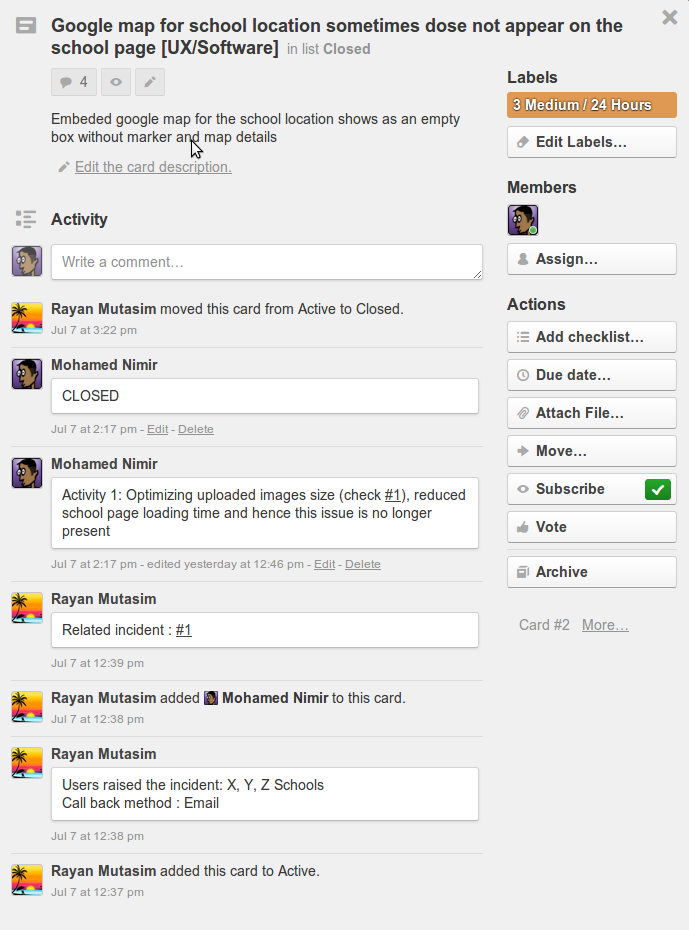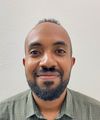Implementing ITSM - Incident Management on kuttab.sd using Trello

Kuttab is an online schools directory presented by Eptikar. The service provides users with a listing of all schools in Khartoum, where each school’s page presents the school’s information and photos plus location map.
Users are able to search and filter schools ,where they can rate and comment on their favorite schools using social media plugins.
In this project we decided to start implementing an Incident management system based on ITSM, in order to improve : service quality, customer satisfaction and IT staff efficiency. We established service desk functionality first to act as single point of contact to receive quires, service requests and incidents which usually come through phone calls or emails.
As a startup company we consist of a single core Dev team, we adopted scrum agile methodology in our project management (SCRUM Development), hence our team construction is based on typical scrum roles:developers, a scrum master and a product owner.
We used Trello , the awesome free web based management application as a tool to implement incident management, we have already had a satisfying experience utilizing Trello for project management using SCRUM Agile methodology.
Trello provides a simple platform for management processes and an easy way to track issues, through this article we share the way we are using Trello for Implementing ITSM Incident management for kuttab online service.
The goal of Incident Management process is to restore a normal service operation as quickly as possible and to minimize the impact on business operations, thus ensuring that the best possible levels of service quality and availability are maintained.
Incident prioritization:
Priority is assessed in terms of two factors; Urgency and Impact, based on ITSM Incident Management the effective way to calculate these elements and deriving an overall priority level for each incident is illustrated using the tables below:
| Impact | ||||
| High | Medium | low | ||
| High | 1 | 2 | 3 | |
| Urgency | Medium | 2 | 3 | 4 |
| Low | 3 | 4 | 5 |
| Priority code | Description | Target resolution time |
|---|---|---|
| 1 | Critical | 1 hour |
| 2 | High | 2 hours |
| 3 | Medium | 24 hours |
| 4 | Low | 48 hours |
| 5 | Planning | Planned |
Incident Escalation:
As you remember we are a single Scrum developing team and we have one scrum master act as the team leader, so according to SCRUM process we response to technical issues collectively and collaboratively with guidance from our scrum master. Although one person might work on an issue but the whole team remains accountable for the result.For this reason we don’t have escalation process in our incident management process flow diagram.
Below is a screen shot of how our Incident management board looks like and as you can see its pretty simple:

A card of an incident looks like this:

Card #2 "related incident" to the card above had been closed after resolving card #1 (Yaay)... and this how it looks like :

So, In order to address all ITSM Incident management standards we need , we used existing features in Trello and just to summarize the post, here is a mapping between the standard and how we applied it with Trello.
[table]
****Incident record Items,****Implementation using Trello
Incident unique reference,Card#
Incident categorization 'incident type',After card title between brackets
Prioritization\, Impact and Urgency,Card colored Labels
Incident logging Date and Time,Card creation date and time
Person recorded the incident,Card creator
Incident Status,Board lists Active Waiting and Closed
Person who will solve the incident,Assigned card member
Description of incident\, user raised it\, call back method,First comment on card
Related Incidents\, activities to solve,Comments on cards and tag of related cards #
Incident closure status\, date and time, last comment indicates (Resolved/Closed)
[/table]
Of course, this is an ongoing experiment and we add and remove things everyday but so far we don't feel the need to move to any specialized software (issue tracking, bugs reporting , ...etc). We like to keep it simple ... for now :)

